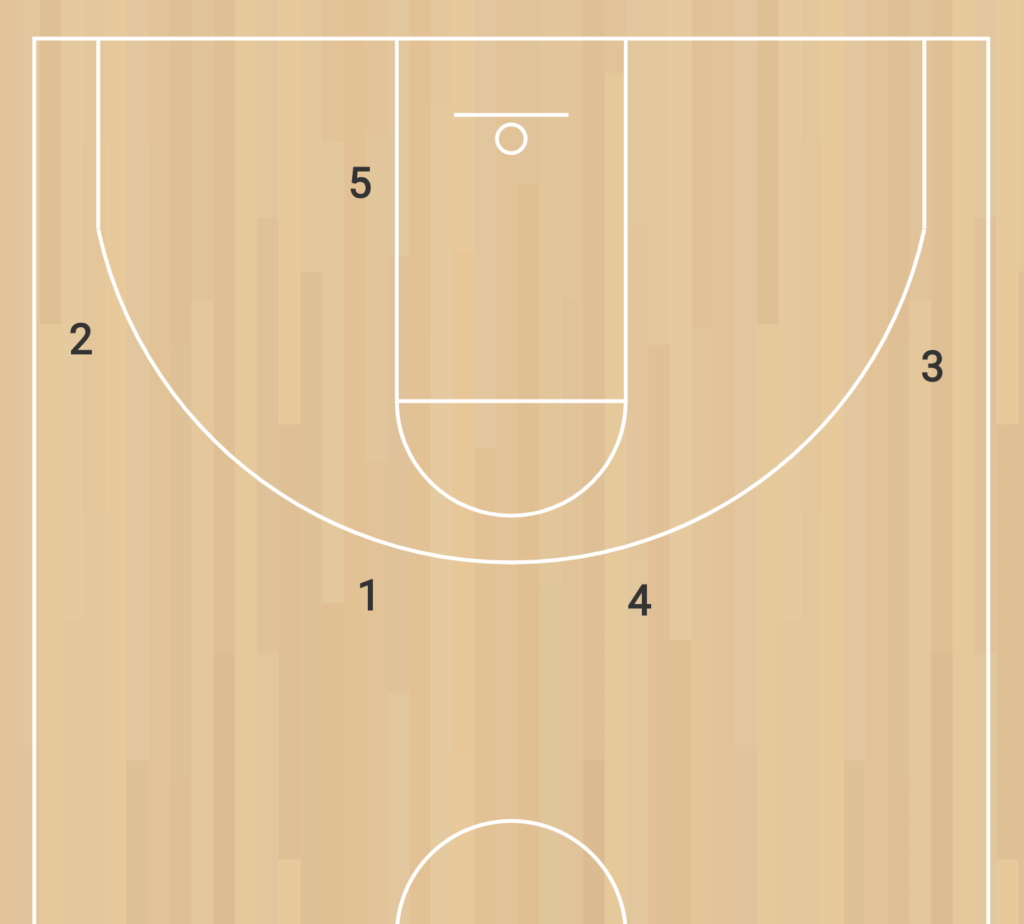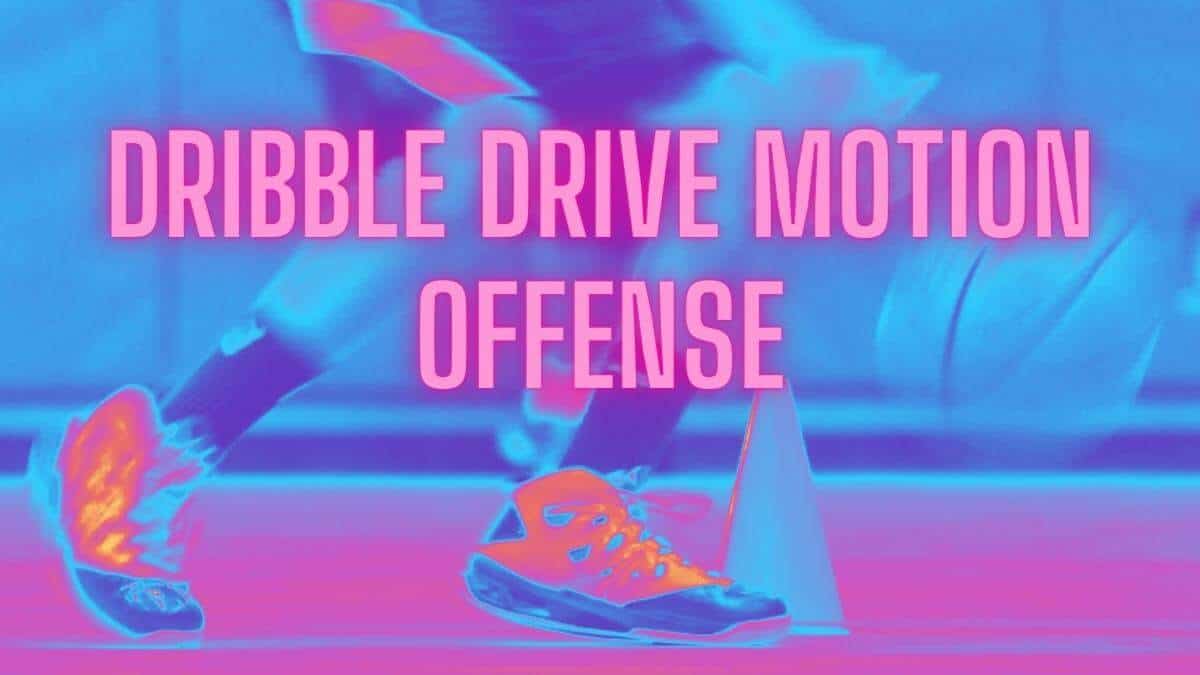The Dribble Drive Motion Offense is a 4-out motion system that’s had a strong run of popularity in the college game in the past 20+ years. This system is basically synonymous with the AASAA offense ( Attack-Attack-Skip-Attack-Attack) and the ‘Memphis attack’ offense. It’s also sometimes called a ‘Walberg offense’ or abbreviated to the DDM offense. I feel like Dribble Drive and DDM just make the most sense, so I’ll try to lean on those.
In the vein of the broader motion offense, the dribble drive motion offense embraces improvisation and spontaneity. Rather than relying on set plays and complicated schemes, it relies on a pattern of constant motion designed to create scoring opportunities.
The strategy was conceived and developed at the High School and Junior College levels in the late 90’s. This sets the Dribble Drive Motion Offense apart as one of the few prominent modern strategic sets to have such humble and recent origins.
It’s well worth it to dive in and take a deeper look at the development of the dribble drive motion offense. So here we’ll do just that, exploring the theory and the history of the dribble drive motion offense.
What Exactly is a Dribble Drive Motion Offense?
To understand the Dribble Drive Motion Offense, you kinda need a solid grasp of motion offense in general. The dribble drive subscribes to the that brand of spontaneous, free wheeling basketball that is rooted in motion offense principles.
The dribble drive is ultimately a class of 4-out motion offense. There’s a lot of similar movements and the initial set is identical, placing the post at the opposite block to the ball entry point.

Where it differs from the traditional 4-out is in an emphasis on those dribble drives. And with a focus on drives, comes a shift in key principles…
Key Principles of the Dribble Drive Motion Offense
As a motion offense, it’s maybe best described in terms of a set of guidelines. Because motion plays can be quite spontaneous, diagrams lose some of their value. Dribble drive offense guidelines end up being very similar to motion offense in general… Of course, with some key details adjusted.
- Drive Into the paint – This is really the point of the whole ‘dribble drive motion’ concept. Drive for a layup. The rest of the system is about what to do when you don’t get that layup.
- Maintain Spacing – Keep adjusting to hold that even 4-out spacing around the arc. This is an obvious hallmark of a motion offense. When the ball handler leaves a gap at the perimeter, everyone works together to fill it in.
- Keep Cycling – On the end of a drive, cut back out to the perimeter to fill that 4-out spacing and the dribble drive continues.
So that describes the motions, that swirling hurricane of offense. The next level of principles (hate to use the word ‘rules’) covers decision making.
- Kick it Out – If your dribble drive hits friction, kick out to the perimeter.
- Post Up – If the post rolls in for help, dump the ball to the post.
- Catch and Shoot – If you get a pass at the perimeter, look first to shoot, then resume the attack.
- Off-Ball Cuts – When the ball is in the high post, the opposite wing cuts backdoor.
- Circle Your Wagons – If the ball is dribbled towards you at the perimeter, go backdoor or accept a dribble handoff.
Key to the dribble drive motion offense is spacing. Spreading the floor and pulling defenders out of the paint allows you to better isolate defenders and promote one-on-one matchups.
This often leads to open lanes to the basket and kick-out opportunities for outside shooters. With a skilled point guard and athletic wings, the dribble drive motion offense can be difficult to defend and a nightmare for opponents.
For deep implementation, there’s a great PDF floating around that covers the X’s and O’s.
Defending against a Dribble Drive Motion Offense
In a pinch, the 2-2-1 press can be remarkably effective. Operated correctly, you can apply a pressure that shuts down a Dribble Drive Motion Offense before it even gets set. If the offense manages to get set, a 2-2-1 compress efficiently to a half court 2-2-1. The half court setup can be maintained over a lengthier period. Certainly be careful about expecting your crew to maintain a strong full-court press over extended minutes.
The effect here is that you’re confronting an offense that’s focused on rapid ball movement in the half court with a defense that forces turnovers across the floor.
You may give up a little friction at the basket by moving your defenders forward. If you can slow down those dribble drives and manage decent perimeter defense, you’ll make that lost ground up in terms of shutdown and turned over plays.
But more broadly, to defend against the dribble drive, look towards limiting penetration. You can try to do that through core defensive tactics, winning your isolations as a team. However, unless there truly are no mismatches to be found, a tight man-to-man is going to offer up gaps.
As always, perhaps more so against a dribble drive motion offense, you need to win possessions. We’ve already discussed trapping. Unfortunately, going for a trap on an offense designed to space the floor can open gaps up even wider.
If this is your issue, shutting off passing routes might be the move. You know that when a drive is shut down, the ball handler is looking to kick out. Defenders should be looking to snag a steal where they can get it, perhaps even at the expense of a clear perimeter shot, provided it puts you in a decent spot for a rebound.
Advantages and Disadvantages of a Dribble Drive Motion Offense
There is no offense without a counter. I mean, maybe without an effective counter, but not entirely without a counter. Anyway, the dribble drive motion offense is no exception. Let’s check it out.
Advantages
- Rapid Pace: A quick, aggressive, penetrating offense can put a defense on their heels and wear them down.
- Generates Confusion: Keeps the defense off balance and guessing.
- Higher scoring potential: The goal is high-percentage shots under the rim. Chances are you’re going to score an easy shot or draw a foul.
- Floor Spacing: By spacing around the perimeter, you’re drawing defenders out of the paint and forcing a defense to cover the whole court. Double teams become extra dangerous.
Disadvantages
- Relatively Advanced: Relies on the ball handler and the rest of the team to stay in sync.
- High-risk: A lot of dribbling, kick-out passing can increase the risk of turnovers and mistakes.
- Counterability: Like any offense, the dribble drive motion offense can be countered by good defensive strategy.
The dribble drive motion offense is an interesting, high-scoring system that offers a lot of advantages. However, it’s important to be aware of the potential drawbacks and to adapt your strategy to your players’ skill levels and opposing defenses.
Dribble Drive Motion Offense Drills
Isolating the dominant behaviors in the dribble drive is crucial to developing it as a viable option for your team. The system is built on dribble penetration, so that becomes a key skill to focus on.
Closeout Reactions
This drill will help players practice the fundamentals of dribble drive motion offense. Start by having players line up in two lines facing each other with a ball at the end of the line.
The first player in one line will have the ball and the first player in the other line will be the defender. The offensive player will start by dribbling towards the defender and then reacting to the defender’s closeout. The offensive player should practice different moves like a jab step or drive to the rim. After the offensive player has gone through the drill, the next player in the line will take the ball and the defender will move to the back of the line.
The point here is to refine that dribble drive aggressively. If we’re reliant on the layup drive as a feature, it better look good for everyone in the rotation.
Dribble Penetration and Kick Out
This drill will help players practice the ability to make quick decisions when dribbling. Have four players line up around the key. The player with the ball will start by dribbling towards the basket. The other players should move to the perimeter to create space. The player with the ball should practice different reactions to the defense. If the defense collapses, the player should kick out to one of the players on the perimeter. If the defense stays back, the player should be able to attack and finish at the rim. After the player has gone through the drill, the next player in the line will take the ball and the other players will rotate.
3 on 3 Half Court
This drill will help players practice the fundamentals of dribble drive motion offense against live defenders. Have three teams of three players each line up on one half of the court. The team with the ball will have the offensive player in the middle and two players on the wings. The offensive player should practice attacking the defense
History of Dribble Drive Motion Offense in Basketball
The Dribble Drive Motion Offense goes back to the late 90s, developed by coach Vance Walberg at Clovis West High School in Fresno, CA. Walberg adopted an AASAA offense in 1997. The system would carry the team to an impressive 5-year record of 159-18.

Vance would lean on the Dribble Drive Motion Offense in his later stints with Fresno City College, and then Pepperdine, where his system picked up the steam required to become a staple on early-2000’s NCAA courts.
Walberg dropped his resignation at Pepperdine after only 2 seasons. But John Calipari has already picked up on Walberg’s AASAA. Calipari took to calling it the ‘dribble drive motion offense’ and the system contributed to an impressive run with the Memphis Tigers. Consequently, the dribble drive is also sometimes referred to as the ‘Memphis attack’ offense.

Vance would later do a couple of stints as an assistant coach at the NBA level under George Karl in both Denver and Sacramento, and elements of the dribble drive motion offense have certainly worked their way up to the pros. Watching NBA play today, it’s hard not to spot some 4-out motion. I’d argue it’s one of the most recognizable strategies in today’s game.
Vance has since returned to Fresno and Clovis West, coaching boys basketball on the same team where he first experimented with his AASAA concepts.
Takeaways
The Dribble Drive Motion Offense represents a particularly effective subset of the broader 4-out Motion schemas that are a staple of today’s NBA basketball.
But this offensive system is perhaps most notable for it’s history. the strategy was built and developed in relatively recent times at the High School level. But it functions, some would say excels, a the College and pro levels.
And the story is uniquely endearing, as Walberg has run up through tenures with some impressive high-level programs, only to return to the coaching at the same High School where he first explored AASAA systems.
